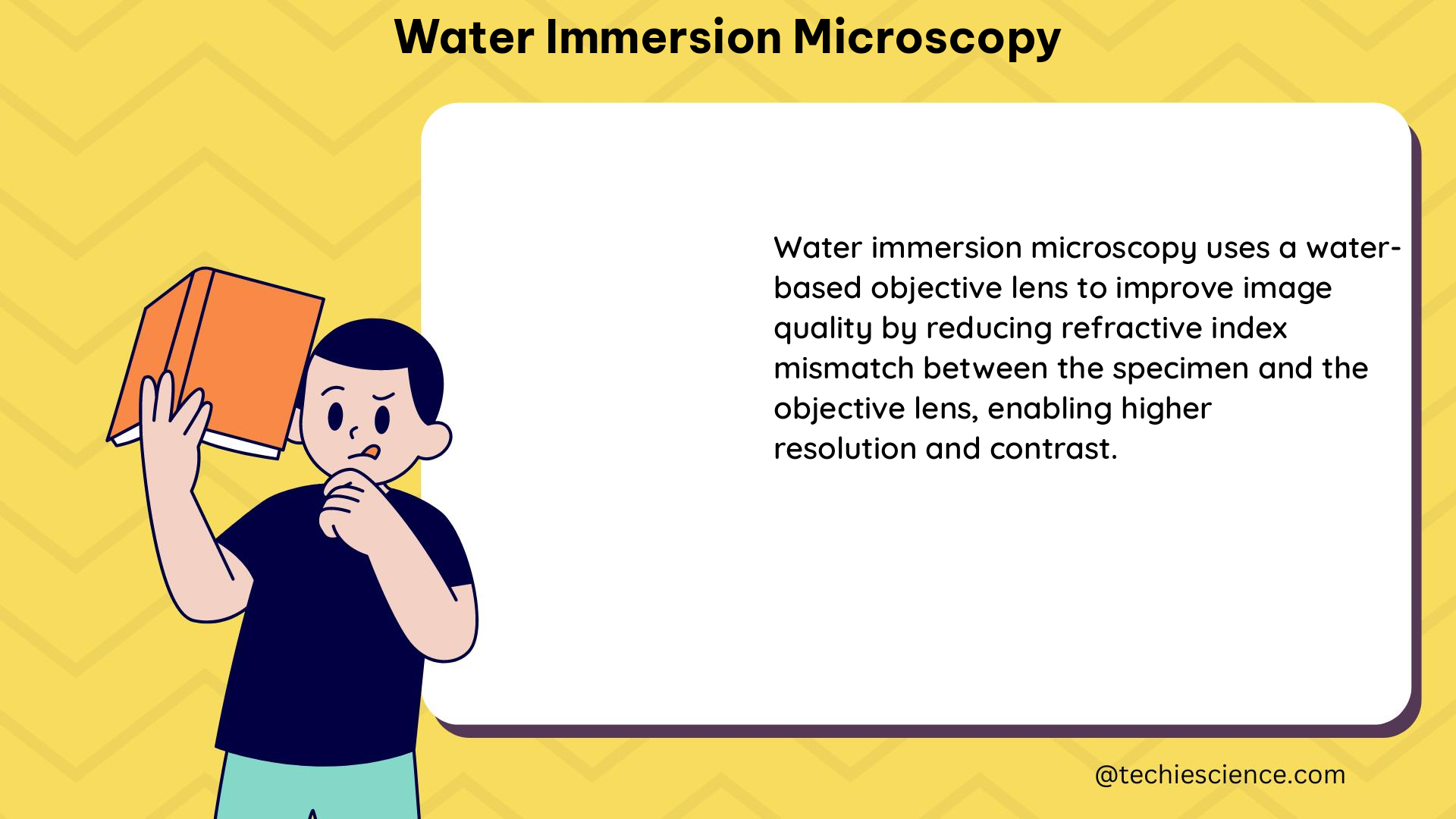Summary
Water immersion microscopy is a powerful technique used in high-resolution microscopy to enhance image quality by utilizing a medium with a higher refractive index than air. This method involves introducing a small amount of water between the objective lens and the sample, effectively bridging the gap and improving light collection. The increased numerical aperture (NA) of the lens, coupled with the reduced spherical aberration, results in sharper, more detailed images, particularly for live cell imaging and fluorescence microscopy.
Understanding the Principles of Water Immersion Microscopy

Refractive Index and Numerical Aperture
The key to the success of water immersion microscopy lies in the refractive index of the medium between the objective lens and the sample. The refractive index of water (1.33) is significantly higher than that of air (1.00), which allows for a greater numerical aperture (NA) of the objective lens. The NA is a measure of the light-gathering ability of the lens and is defined by the following equation:
NA = n × sin(θ)
Where:
– n is the refractive index of the medium
– θ is the half-angle of the maximum cone of light that can enter or exit the lens
By using water as the immersion medium, the NA of the objective lens can be increased, leading to a higher resolution and better light collection. This is particularly important for high-magnification objectives, where the NA is a critical factor in determining the overall image quality.
Reduction of Spherical Aberration
Another key benefit of water immersion microscopy is the reduction of spherical aberration, a common issue in high-resolution fluorescence microscopy. Spherical aberration occurs when light rays passing through the objective lens are not focused to a single point, resulting in a blurred image. This can be caused by differences in the refractive index between the objective and the sample, or by the curvature of the sample itself.
By using water as the immersion medium, the refractive index mismatch between the objective and the sample is minimized, effectively reducing or eliminating spherical aberration. This allows for better signal levels and improved image quality in high-resolution fluorescence microscopy applications.
Improved Live Cell Imaging
Water immersion microscopy is particularly useful for imaging live cells, as the water-based environment helps to maintain the natural state of the cells and reduces the risk of damage or distortion. The water medium bridges the gap between the objective lens and the sample, allowing for a closer working distance and better optical coupling. This, in turn, leads to improved image quality and the ability to observe dynamic cellular processes in real-time.
Quantifiable Data and Practical Considerations
Laser Beam Characterization
A study using the knife-edge method has provided quantifiable data on the characteristics of the laser beam exiting the objective lens in a laser scanning microscope. The researchers were able to measure the following parameters:
- Beam waist
- Divergence
- Ellipticity
- Astigmatism
By scanning the laser spot from a reflective to a transmitting part of a simple transmission electron microscopy grid attached to a glass microscope slide, and using a light-collecting optical fiber and photodiode underneath the specimen, the researchers were able to obtain these important beam parameters. The measured divergence can be used to quantify how much of the full numerical aperture of the lens is used in practice.
Numerical Aperture and Laser Wavelength
The choice of numerical aperture and laser wavelength are critical factors in water immersion microscopy. Higher NA objectives, typically in the range of 40x to 100x, are most commonly used in this technique to take advantage of the increased light-gathering ability. The wavelength of the laser used in the microscope system should also be carefully selected to match the specific application and sample characteristics.
For example, in confocal and multiphoton laser scanning microscopy, researchers have reported using low (0.15, 0.7) and high (1.3) NA lenses, along with lasers of various wavelengths, to achieve optimal performance.
Sample Preparation and Handling
When working with water immersion microscopy, it is essential to pay close attention to sample preparation and handling. The sample must be properly mounted and contained within a chamber or slide that allows for the introduction of the water immersion medium. Careful control of the water volume and distribution is crucial to ensure consistent and reliable results.
Additionally, the temperature and pH of the water used for immersion should be monitored and maintained within the appropriate range to avoid any adverse effects on the sample or the microscope components.
Conclusion
Water immersion microscopy is a powerful technique that leverages the higher refractive index of water to enhance the resolution and image quality of high-magnification microscopy. By increasing the numerical aperture of the objective lens and reducing spherical aberration, this method enables improved live cell imaging and high-resolution fluorescence microscopy.
The quantifiable data, such as laser beam characteristics and the relationship between numerical aperture and laser wavelength, provide valuable insights for physicists and researchers working in the field of advanced microscopy. With a thorough understanding of the principles and practical considerations, water immersion microscopy can be a valuable tool in a wide range of scientific applications.
References:
- Microscopy U – Water Immersion Objectives
- Thorlabs – Water Immersion Objectives
- NCBI – Characterization of Laser Beam Focusing through High-Numerical-Aperture Objectives
- Navitar – Water Immersion Objective
- Microscopy U – Immersion Oil Selection Guide
- Microscopy U – Immersion Oil Basics
- Microscopy U – Water Immersion Objectives Basics

The lambdageeks.com Core SME Team is a group of experienced subject matter experts from diverse scientific and technical fields including Physics, Chemistry, Technology,Electronics & Electrical Engineering, Automotive, Mechanical Engineering. Our team collaborates to create high-quality, well-researched articles on a wide range of science and technology topics for the lambdageeks.com website.
All Our Senior SME are having more than 7 Years of experience in the respective fields . They are either Working Industry Professionals or assocaited With different Universities. Refer Our Authors Page to get to know About our Core SMEs.